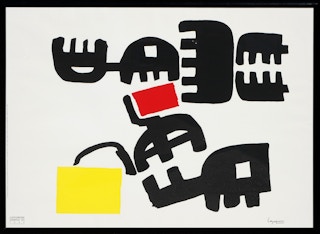Material
Serigraph
About
Black, yellow, and red modernist abstract serigraph by Italian artist Giuseppe Capogrossi. Originally printed in 1959, the serigraph was reprinted in Italy in 1988. The piece features black abstracted shapes resembling figures with teeth-like features, contrasted against red and yellow rectangular shapes. Framed in a modern black frame.
Artist Biography
Giuseppe Capogrossi was born on March 7, 1900, in Rome. In 1922 he completed his law degree but soon after devoted himself entirely to painting and joined Felice Carena's atelier. Between 1927 and 1931, Capogrossi traveled frequently to Paris, and along with Corrado Cagli and Emanuele Cavalli worked in a figurative style characterized by pale and ethereal tones, which endowed their compositions with a mysterious, almost magical aura. The three artists were among the loose association of painters that came to be known as Scuola Romana (Roman School). In 1933 they collaborated on the "Manifesto del primordialismo plastico" (Manifesto of plastic primordialism), in which they discussed the presence of the archaic in the contemporary world. From the mid-1930s, Capogrossi adopted a darker palette, and between 1945 and 1948 his figurative tonal painting gave way to an increasingly abstract geometric style. A decisive shift in Capogrossi's career took place in 1949, when he developed a vocabulary of irregular comb- or fork-shaped signs. With no allegorical, psychological, or symbolic meanings, these structural elements could be assembled and connected in countless variations. Intricate and insistent, Capogrossi's signs determined the construction of the pictorial surface. Similar to mysterious lists or sequences, his paintings were immediate in their appeal yet remained hard to decode, a quality he shared with Art Informel practitioners. These abstract comb-sign paintings, usually known simply as Surfaces (Superficies), were begun in 1949 and first exhibited at the Galleria del secolo, Rome, in 1950. Soon becoming the hallmark of Capogrossi's style, the comb sign dominated his oeuvre until the end of his career. In 1951, Capogrossi joined Mario Ballocco, Alberto Burri, and Ettore Colla in showing work at Aurora 41, Rome, an occasion that marked the debut of the group Origine (Origin, 1950–51). Primarily concerned with the promotion of abstract art, the group reacted against mainstream realist practices and advocated a simplified language meant to return art to its origins. The following year, Capogrossi joined the Movimento spaziale (Spatial movement, 1947–60), initiated by Lucio Fontana in Milan. Readily embracing the many changes affecting the country in the postwar era, especially scientific progress, the group advocated for a new spatial art that acknowledged recent inventions such as television and neon lighting. Capogrossi's singularity was recognized both in Italy and abroad, and he took part in group exhibitions at Galerie Nina Dausset, Paris (1951); Guggenheim Museum (1953); Venice Biennale (1954, 1962); Documenta, Kassel, West Germany (1955, 1959); Carnegie International, Pittsburgh (1958, 1961); and Tate Gallery, London (1964). Capogrossi has also been the subject of numerous solo shows at institutions including the Institute of Contemporary Arts, London (1957); Leo Castelli Gallery, New York (1958); Palais des beaux-arts, Brussels (1959); and Galleria L'attico, Rome (1962). Capogrossi died on October 9, 1972, in Rome. Two years later the Galleria nazionale d'arte moderna, Rome, organized his first major posthumous retrospective.
Dimensions With Frame
H: 19.25 in. x W: 15.25 in.
Dimensions Without Frame
H 42 in x W 57 in x D 0.5 in
